The Impact of Corporate Governance on ASX Listed Companies: A Study
VerifiedAdded on 2023/06/15
|9
|2364
|444
Essay
AI Summary
This essay provides an overview of corporate governance in the context of the Australian Securities Exchange (ASX) listing rules. It discusses the principles and recommendations set forth by the ASX Corporate Governance Council, emphasizing their role in promoting investor confidence and assisting listed companies in meeting stakeholder expectations. The essay highlights the importance of continuous disclosure and the "if not, why not" approach, which allows companies to deviate from recommendations if justified. It also examines the relationship between ASX and listed entities, focusing on the minimum standards of quality, size, and disclosure required for maintaining market integrity. Furthermore, the essay suggests potential amendments to the listing principles to enhance corporate governance for both listed and unlisted companies, ultimately contributing to long-term success and value creation.

Running head: CORPORATE LAW
Corporate Law
Name of the Student
Name of the University
Author note
Corporate Law
Name of the Student
Name of the University
Author note
Paraphrase This Document
Need a fresh take? Get an instant paraphrase of this document with our AI Paraphraser
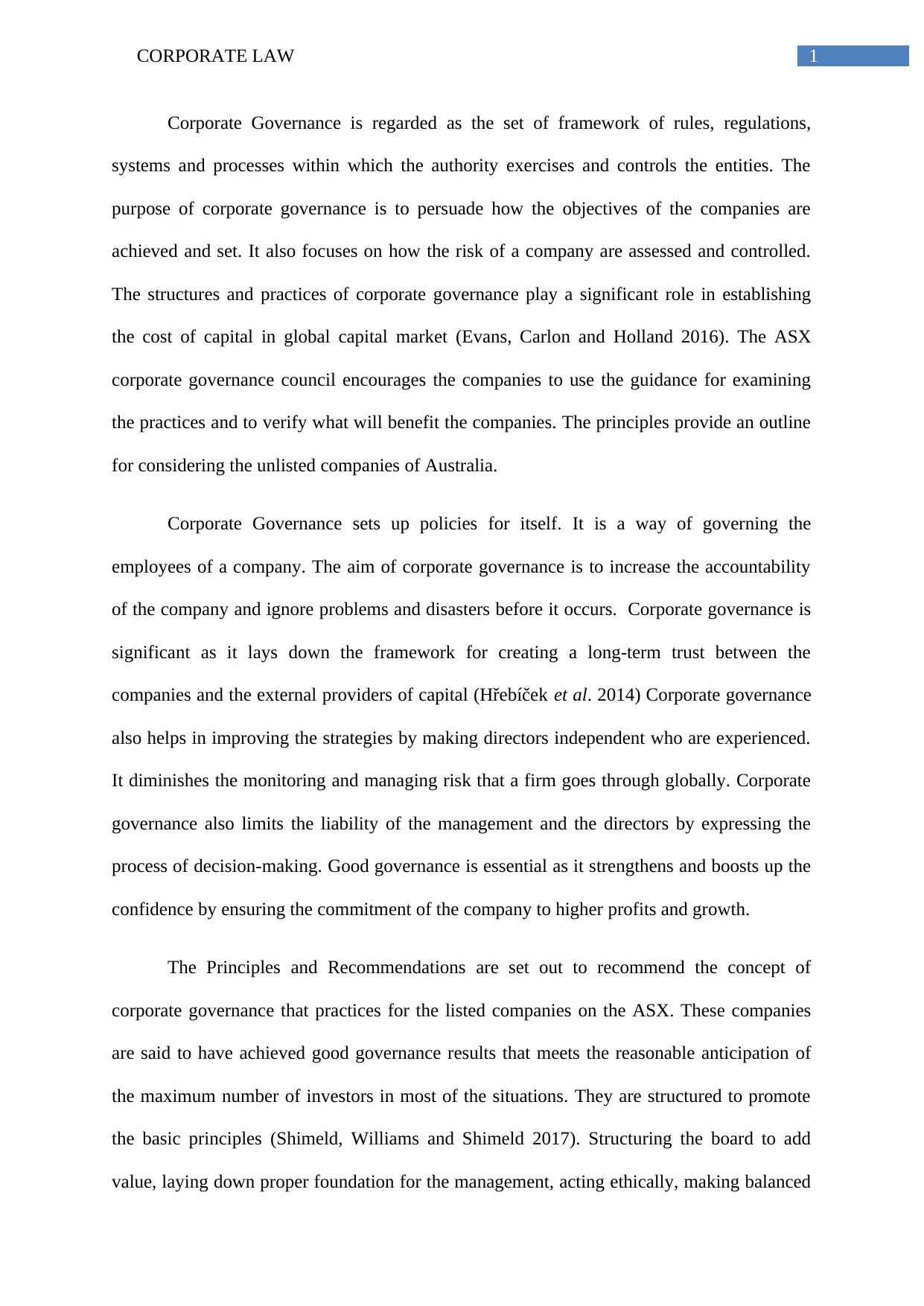
1CORPORATE LAW
Corporate Governance is regarded as the set of framework of rules, regulations,
systems and processes within which the authority exercises and controls the entities. The
purpose of corporate governance is to persuade how the objectives of the companies are
achieved and set. It also focuses on how the risk of a company are assessed and controlled.
The structures and practices of corporate governance play a significant role in establishing
the cost of capital in global capital market (Evans, Carlon and Holland 2016). The ASX
corporate governance council encourages the companies to use the guidance for examining
the practices and to verify what will benefit the companies. The principles provide an outline
for considering the unlisted companies of Australia.
Corporate Governance sets up policies for itself. It is a way of governing the
employees of a company. The aim of corporate governance is to increase the accountability
of the company and ignore problems and disasters before it occurs. Corporate governance is
significant as it lays down the framework for creating a long-term trust between the
companies and the external providers of capital (Hřebíček et al. 2014) Corporate governance
also helps in improving the strategies by making directors independent who are experienced.
It diminishes the monitoring and managing risk that a firm goes through globally. Corporate
governance also limits the liability of the management and the directors by expressing the
process of decision-making. Good governance is essential as it strengthens and boosts up the
confidence by ensuring the commitment of the company to higher profits and growth.
The Principles and Recommendations are set out to recommend the concept of
corporate governance that practices for the listed companies on the ASX. These companies
are said to have achieved good governance results that meets the reasonable anticipation of
the maximum number of investors in most of the situations. They are structured to promote
the basic principles (Shimeld, Williams and Shimeld 2017). Structuring the board to add
value, laying down proper foundation for the management, acting ethically, making balanced
Corporate Governance is regarded as the set of framework of rules, regulations,
systems and processes within which the authority exercises and controls the entities. The
purpose of corporate governance is to persuade how the objectives of the companies are
achieved and set. It also focuses on how the risk of a company are assessed and controlled.
The structures and practices of corporate governance play a significant role in establishing
the cost of capital in global capital market (Evans, Carlon and Holland 2016). The ASX
corporate governance council encourages the companies to use the guidance for examining
the practices and to verify what will benefit the companies. The principles provide an outline
for considering the unlisted companies of Australia.
Corporate Governance sets up policies for itself. It is a way of governing the
employees of a company. The aim of corporate governance is to increase the accountability
of the company and ignore problems and disasters before it occurs. Corporate governance is
significant as it lays down the framework for creating a long-term trust between the
companies and the external providers of capital (Hřebíček et al. 2014) Corporate governance
also helps in improving the strategies by making directors independent who are experienced.
It diminishes the monitoring and managing risk that a firm goes through globally. Corporate
governance also limits the liability of the management and the directors by expressing the
process of decision-making. Good governance is essential as it strengthens and boosts up the
confidence by ensuring the commitment of the company to higher profits and growth.
The Principles and Recommendations are set out to recommend the concept of
corporate governance that practices for the listed companies on the ASX. These companies
are said to have achieved good governance results that meets the reasonable anticipation of
the maximum number of investors in most of the situations. They are structured to promote
the basic principles (Shimeld, Williams and Shimeld 2017). Structuring the board to add
value, laying down proper foundation for the management, acting ethically, making balanced
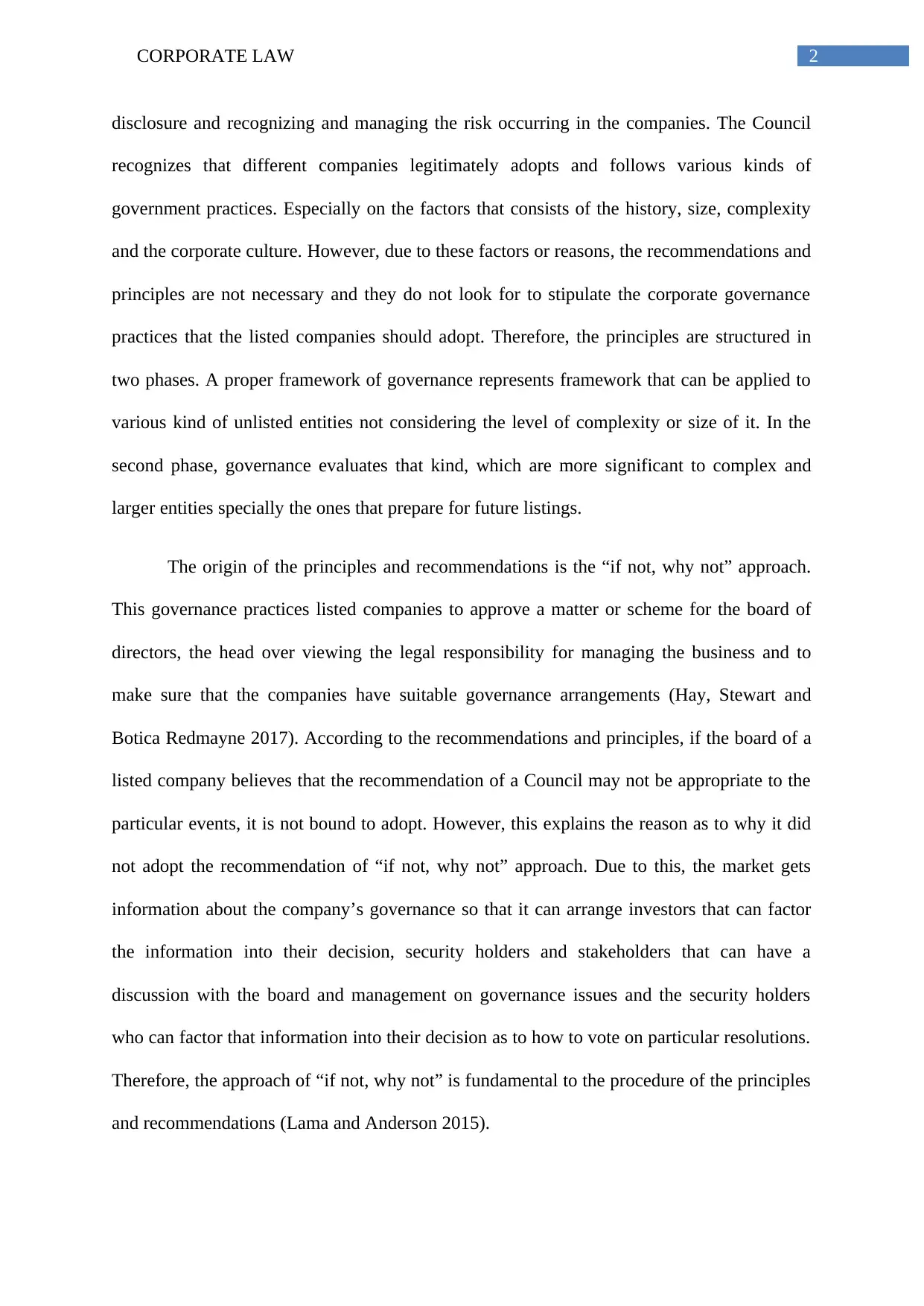
2CORPORATE LAW
disclosure and recognizing and managing the risk occurring in the companies. The Council
recognizes that different companies legitimately adopts and follows various kinds of
government practices. Especially on the factors that consists of the history, size, complexity
and the corporate culture. However, due to these factors or reasons, the recommendations and
principles are not necessary and they do not look for to stipulate the corporate governance
practices that the listed companies should adopt. Therefore, the principles are structured in
two phases. A proper framework of governance represents framework that can be applied to
various kind of unlisted entities not considering the level of complexity or size of it. In the
second phase, governance evaluates that kind, which are more significant to complex and
larger entities specially the ones that prepare for future listings.
The origin of the principles and recommendations is the “if not, why not” approach.
This governance practices listed companies to approve a matter or scheme for the board of
directors, the head over viewing the legal responsibility for managing the business and to
make sure that the companies have suitable governance arrangements (Hay, Stewart and
Botica Redmayne 2017). According to the recommendations and principles, if the board of a
listed company believes that the recommendation of a Council may not be appropriate to the
particular events, it is not bound to adopt. However, this explains the reason as to why it did
not adopt the recommendation of “if not, why not” approach. Due to this, the market gets
information about the company’s governance so that it can arrange investors that can factor
the information into their decision, security holders and stakeholders that can have a
discussion with the board and management on governance issues and the security holders
who can factor that information into their decision as to how to vote on particular resolutions.
Therefore, the approach of “if not, why not” is fundamental to the procedure of the principles
and recommendations (Lama and Anderson 2015).
disclosure and recognizing and managing the risk occurring in the companies. The Council
recognizes that different companies legitimately adopts and follows various kinds of
government practices. Especially on the factors that consists of the history, size, complexity
and the corporate culture. However, due to these factors or reasons, the recommendations and
principles are not necessary and they do not look for to stipulate the corporate governance
practices that the listed companies should adopt. Therefore, the principles are structured in
two phases. A proper framework of governance represents framework that can be applied to
various kind of unlisted entities not considering the level of complexity or size of it. In the
second phase, governance evaluates that kind, which are more significant to complex and
larger entities specially the ones that prepare for future listings.
The origin of the principles and recommendations is the “if not, why not” approach.
This governance practices listed companies to approve a matter or scheme for the board of
directors, the head over viewing the legal responsibility for managing the business and to
make sure that the companies have suitable governance arrangements (Hay, Stewart and
Botica Redmayne 2017). According to the recommendations and principles, if the board of a
listed company believes that the recommendation of a Council may not be appropriate to the
particular events, it is not bound to adopt. However, this explains the reason as to why it did
not adopt the recommendation of “if not, why not” approach. Due to this, the market gets
information about the company’s governance so that it can arrange investors that can factor
the information into their decision, security holders and stakeholders that can have a
discussion with the board and management on governance issues and the security holders
who can factor that information into their decision as to how to vote on particular resolutions.
Therefore, the approach of “if not, why not” is fundamental to the procedure of the principles
and recommendations (Lama and Anderson 2015).
⊘ This is a preview!⊘
Do you want full access?
Subscribe today to unlock all pages.

Trusted by 1+ million students worldwide
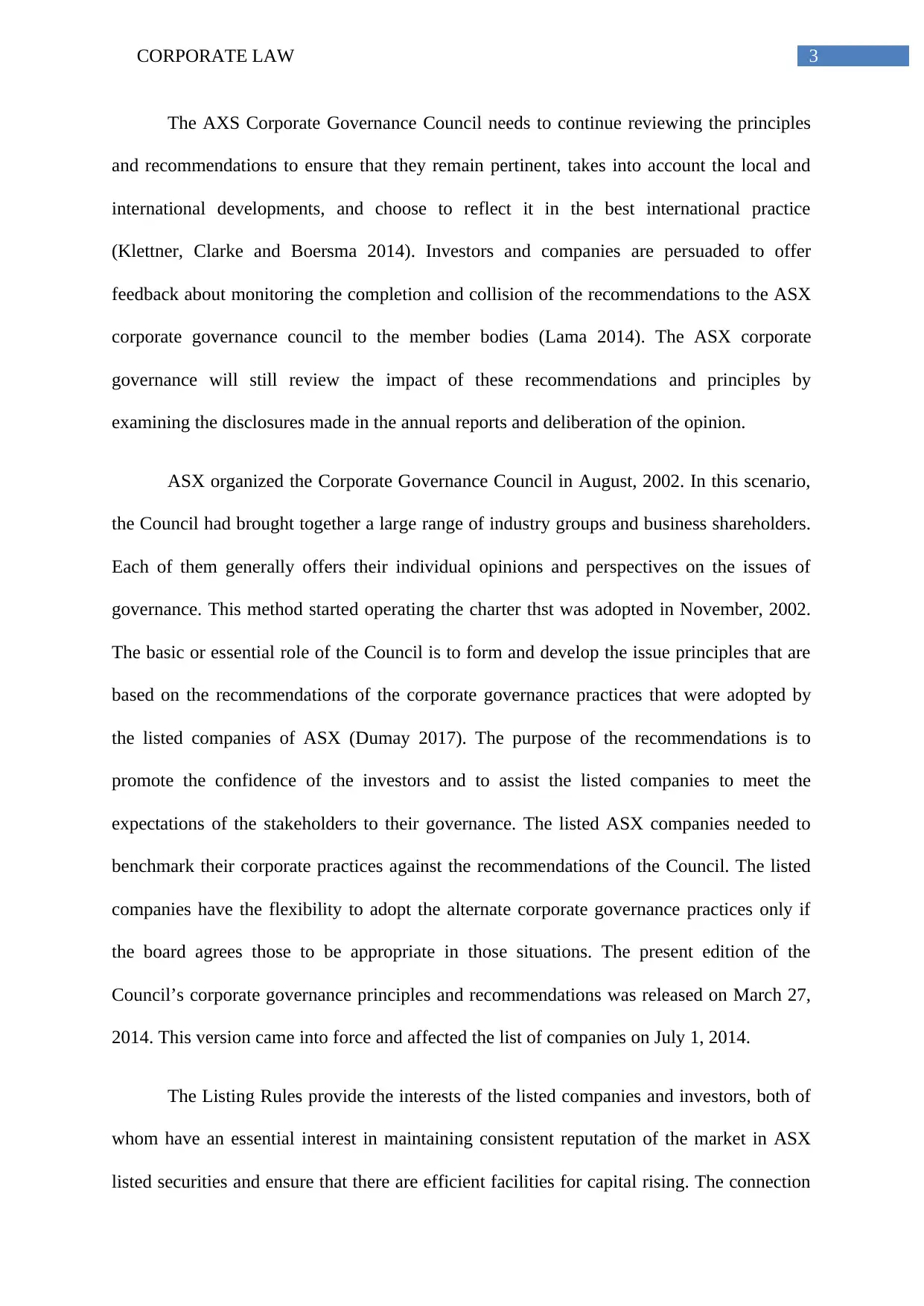
3CORPORATE LAW
The AXS Corporate Governance Council needs to continue reviewing the principles
and recommendations to ensure that they remain pertinent, takes into account the local and
international developments, and choose to reflect it in the best international practice
(Klettner, Clarke and Boersma 2014). Investors and companies are persuaded to offer
feedback about monitoring the completion and collision of the recommendations to the ASX
corporate governance council to the member bodies (Lama 2014). The ASX corporate
governance will still review the impact of these recommendations and principles by
examining the disclosures made in the annual reports and deliberation of the opinion.
ASX organized the Corporate Governance Council in August, 2002. In this scenario,
the Council had brought together a large range of industry groups and business shareholders.
Each of them generally offers their individual opinions and perspectives on the issues of
governance. This method started operating the charter thst was adopted in November, 2002.
The basic or essential role of the Council is to form and develop the issue principles that are
based on the recommendations of the corporate governance practices that were adopted by
the listed companies of ASX (Dumay 2017). The purpose of the recommendations is to
promote the confidence of the investors and to assist the listed companies to meet the
expectations of the stakeholders to their governance. The listed ASX companies needed to
benchmark their corporate practices against the recommendations of the Council. The listed
companies have the flexibility to adopt the alternate corporate governance practices only if
the board agrees those to be appropriate in those situations. The present edition of the
Council’s corporate governance principles and recommendations was released on March 27,
2014. This version came into force and affected the list of companies on July 1, 2014.
The Listing Rules provide the interests of the listed companies and investors, both of
whom have an essential interest in maintaining consistent reputation of the market in ASX
listed securities and ensure that there are efficient facilities for capital rising. The connection
The AXS Corporate Governance Council needs to continue reviewing the principles
and recommendations to ensure that they remain pertinent, takes into account the local and
international developments, and choose to reflect it in the best international practice
(Klettner, Clarke and Boersma 2014). Investors and companies are persuaded to offer
feedback about monitoring the completion and collision of the recommendations to the ASX
corporate governance council to the member bodies (Lama 2014). The ASX corporate
governance will still review the impact of these recommendations and principles by
examining the disclosures made in the annual reports and deliberation of the opinion.
ASX organized the Corporate Governance Council in August, 2002. In this scenario,
the Council had brought together a large range of industry groups and business shareholders.
Each of them generally offers their individual opinions and perspectives on the issues of
governance. This method started operating the charter thst was adopted in November, 2002.
The basic or essential role of the Council is to form and develop the issue principles that are
based on the recommendations of the corporate governance practices that were adopted by
the listed companies of ASX (Dumay 2017). The purpose of the recommendations is to
promote the confidence of the investors and to assist the listed companies to meet the
expectations of the stakeholders to their governance. The listed ASX companies needed to
benchmark their corporate practices against the recommendations of the Council. The listed
companies have the flexibility to adopt the alternate corporate governance practices only if
the board agrees those to be appropriate in those situations. The present edition of the
Council’s corporate governance principles and recommendations was released on March 27,
2014. This version came into force and affected the list of companies on July 1, 2014.
The Listing Rules provide the interests of the listed companies and investors, both of
whom have an essential interest in maintaining consistent reputation of the market in ASX
listed securities and ensure that there are efficient facilities for capital rising. The connection
Paraphrase This Document
Need a fresh take? Get an instant paraphrase of this document with our AI Paraphraser
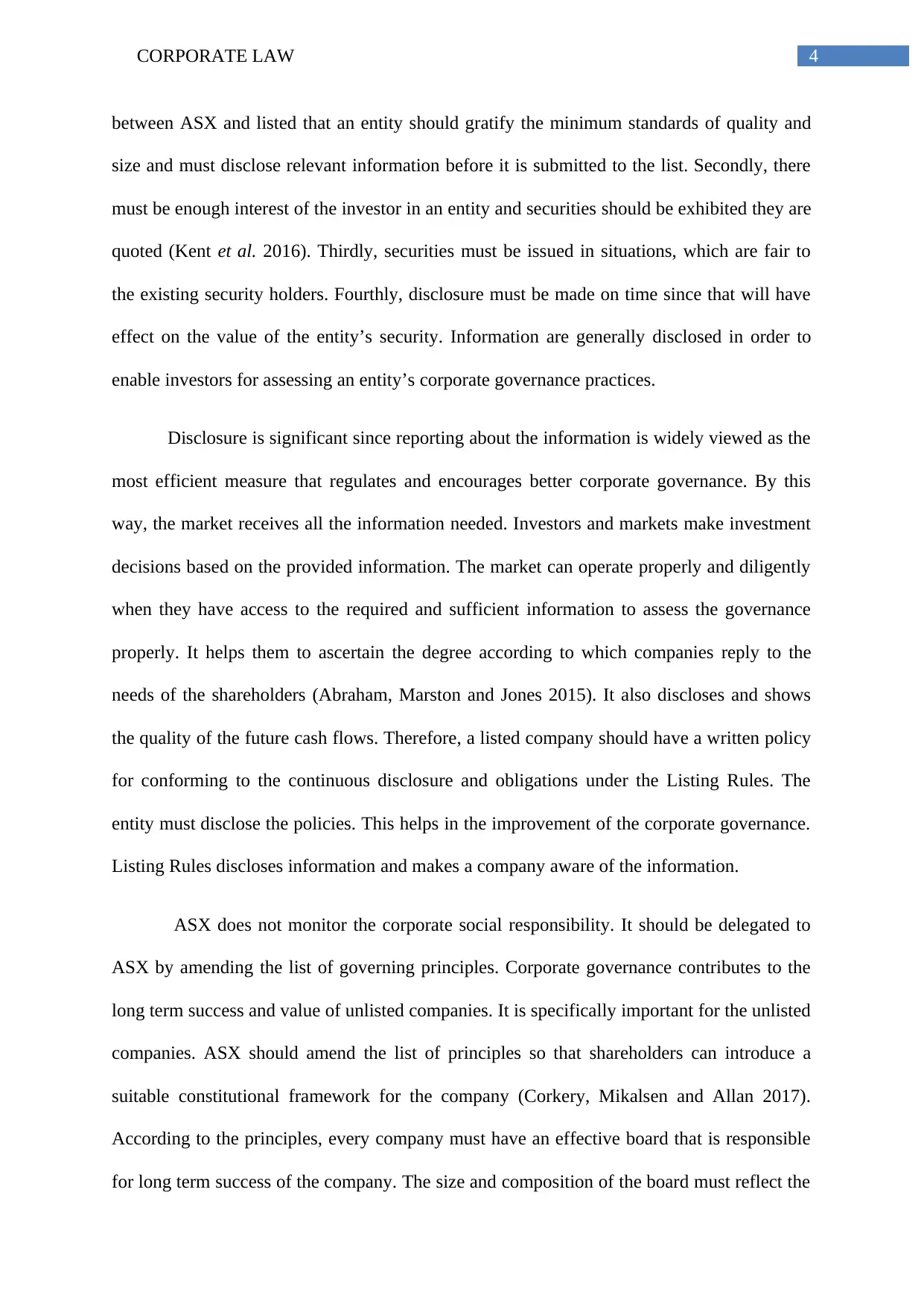
4CORPORATE LAW
between ASX and listed that an entity should gratify the minimum standards of quality and
size and must disclose relevant information before it is submitted to the list. Secondly, there
must be enough interest of the investor in an entity and securities should be exhibited they are
quoted (Kent et al. 2016). Thirdly, securities must be issued in situations, which are fair to
the existing security holders. Fourthly, disclosure must be made on time since that will have
effect on the value of the entity’s security. Information are generally disclosed in order to
enable investors for assessing an entity’s corporate governance practices.
Disclosure is significant since reporting about the information is widely viewed as the
most efficient measure that regulates and encourages better corporate governance. By this
way, the market receives all the information needed. Investors and markets make investment
decisions based on the provided information. The market can operate properly and diligently
when they have access to the required and sufficient information to assess the governance
properly. It helps them to ascertain the degree according to which companies reply to the
needs of the shareholders (Abraham, Marston and Jones 2015). It also discloses and shows
the quality of the future cash flows. Therefore, a listed company should have a written policy
for conforming to the continuous disclosure and obligations under the Listing Rules. The
entity must disclose the policies. This helps in the improvement of the corporate governance.
Listing Rules discloses information and makes a company aware of the information.
ASX does not monitor the corporate social responsibility. It should be delegated to
ASX by amending the list of governing principles. Corporate governance contributes to the
long term success and value of unlisted companies. It is specifically important for the unlisted
companies. ASX should amend the list of principles so that shareholders can introduce a
suitable constitutional framework for the company (Corkery, Mikalsen and Allan 2017).
According to the principles, every company must have an effective board that is responsible
for long term success of the company. The size and composition of the board must reflect the
between ASX and listed that an entity should gratify the minimum standards of quality and
size and must disclose relevant information before it is submitted to the list. Secondly, there
must be enough interest of the investor in an entity and securities should be exhibited they are
quoted (Kent et al. 2016). Thirdly, securities must be issued in situations, which are fair to
the existing security holders. Fourthly, disclosure must be made on time since that will have
effect on the value of the entity’s security. Information are generally disclosed in order to
enable investors for assessing an entity’s corporate governance practices.
Disclosure is significant since reporting about the information is widely viewed as the
most efficient measure that regulates and encourages better corporate governance. By this
way, the market receives all the information needed. Investors and markets make investment
decisions based on the provided information. The market can operate properly and diligently
when they have access to the required and sufficient information to assess the governance
properly. It helps them to ascertain the degree according to which companies reply to the
needs of the shareholders (Abraham, Marston and Jones 2015). It also discloses and shows
the quality of the future cash flows. Therefore, a listed company should have a written policy
for conforming to the continuous disclosure and obligations under the Listing Rules. The
entity must disclose the policies. This helps in the improvement of the corporate governance.
Listing Rules discloses information and makes a company aware of the information.
ASX does not monitor the corporate social responsibility. It should be delegated to
ASX by amending the list of governing principles. Corporate governance contributes to the
long term success and value of unlisted companies. It is specifically important for the unlisted
companies. ASX should amend the list of principles so that shareholders can introduce a
suitable constitutional framework for the company (Corkery, Mikalsen and Allan 2017).
According to the principles, every company must have an effective board that is responsible
for long term success of the company. The size and composition of the board must reflect the
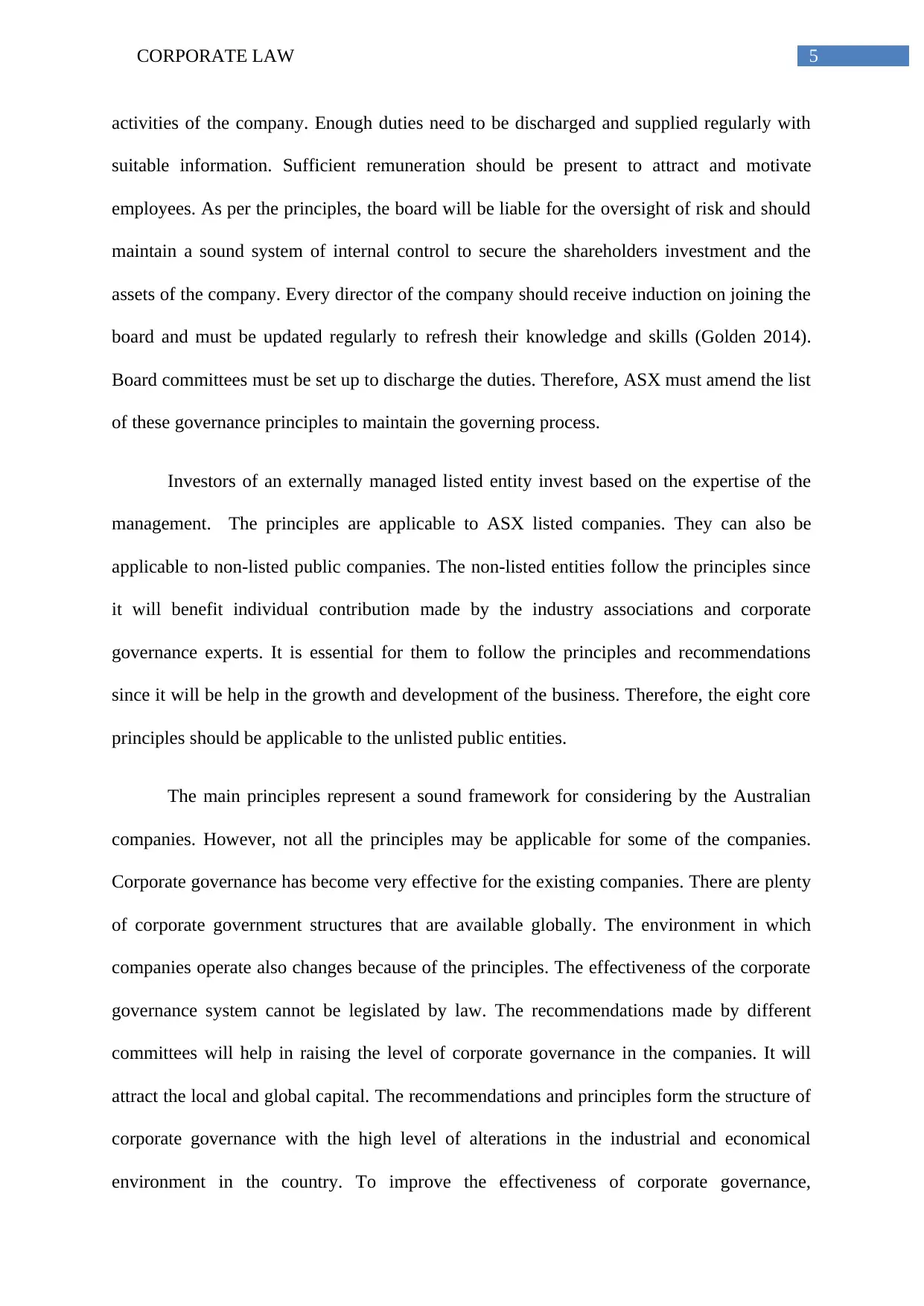
5CORPORATE LAW
activities of the company. Enough duties need to be discharged and supplied regularly with
suitable information. Sufficient remuneration should be present to attract and motivate
employees. As per the principles, the board will be liable for the oversight of risk and should
maintain a sound system of internal control to secure the shareholders investment and the
assets of the company. Every director of the company should receive induction on joining the
board and must be updated regularly to refresh their knowledge and skills (Golden 2014).
Board committees must be set up to discharge the duties. Therefore, ASX must amend the list
of these governance principles to maintain the governing process.
Investors of an externally managed listed entity invest based on the expertise of the
management. The principles are applicable to ASX listed companies. They can also be
applicable to non-listed public companies. The non-listed entities follow the principles since
it will benefit individual contribution made by the industry associations and corporate
governance experts. It is essential for them to follow the principles and recommendations
since it will be help in the growth and development of the business. Therefore, the eight core
principles should be applicable to the unlisted public entities.
The main principles represent a sound framework for considering by the Australian
companies. However, not all the principles may be applicable for some of the companies.
Corporate governance has become very effective for the existing companies. There are plenty
of corporate government structures that are available globally. The environment in which
companies operate also changes because of the principles. The effectiveness of the corporate
governance system cannot be legislated by law. The recommendations made by different
committees will help in raising the level of corporate governance in the companies. It will
attract the local and global capital. The recommendations and principles form the structure of
corporate governance with the high level of alterations in the industrial and economical
environment in the country. To improve the effectiveness of corporate governance,
activities of the company. Enough duties need to be discharged and supplied regularly with
suitable information. Sufficient remuneration should be present to attract and motivate
employees. As per the principles, the board will be liable for the oversight of risk and should
maintain a sound system of internal control to secure the shareholders investment and the
assets of the company. Every director of the company should receive induction on joining the
board and must be updated regularly to refresh their knowledge and skills (Golden 2014).
Board committees must be set up to discharge the duties. Therefore, ASX must amend the list
of these governance principles to maintain the governing process.
Investors of an externally managed listed entity invest based on the expertise of the
management. The principles are applicable to ASX listed companies. They can also be
applicable to non-listed public companies. The non-listed entities follow the principles since
it will benefit individual contribution made by the industry associations and corporate
governance experts. It is essential for them to follow the principles and recommendations
since it will be help in the growth and development of the business. Therefore, the eight core
principles should be applicable to the unlisted public entities.
The main principles represent a sound framework for considering by the Australian
companies. However, not all the principles may be applicable for some of the companies.
Corporate governance has become very effective for the existing companies. There are plenty
of corporate government structures that are available globally. The environment in which
companies operate also changes because of the principles. The effectiveness of the corporate
governance system cannot be legislated by law. The recommendations made by different
committees will help in raising the level of corporate governance in the companies. It will
attract the local and global capital. The recommendations and principles form the structure of
corporate governance with the high level of alterations in the industrial and economical
environment in the country. To improve the effectiveness of corporate governance,
⊘ This is a preview!⊘
Do you want full access?
Subscribe today to unlock all pages.

Trusted by 1+ million students worldwide

6CORPORATE LAW
disclosures and regulators should be maintained. Regulators and investors must follow the
methods provided in the guidelines on the mentioned corporate governance disclosure
requirements. The ASX corporate governance will remain reviewing the force of these
recommendations and principles by examining the disclosures made in the annual reports and
deliberation of the feedback.
disclosures and regulators should be maintained. Regulators and investors must follow the
methods provided in the guidelines on the mentioned corporate governance disclosure
requirements. The ASX corporate governance will remain reviewing the force of these
recommendations and principles by examining the disclosures made in the annual reports and
deliberation of the feedback.
Paraphrase This Document
Need a fresh take? Get an instant paraphrase of this document with our AI Paraphraser
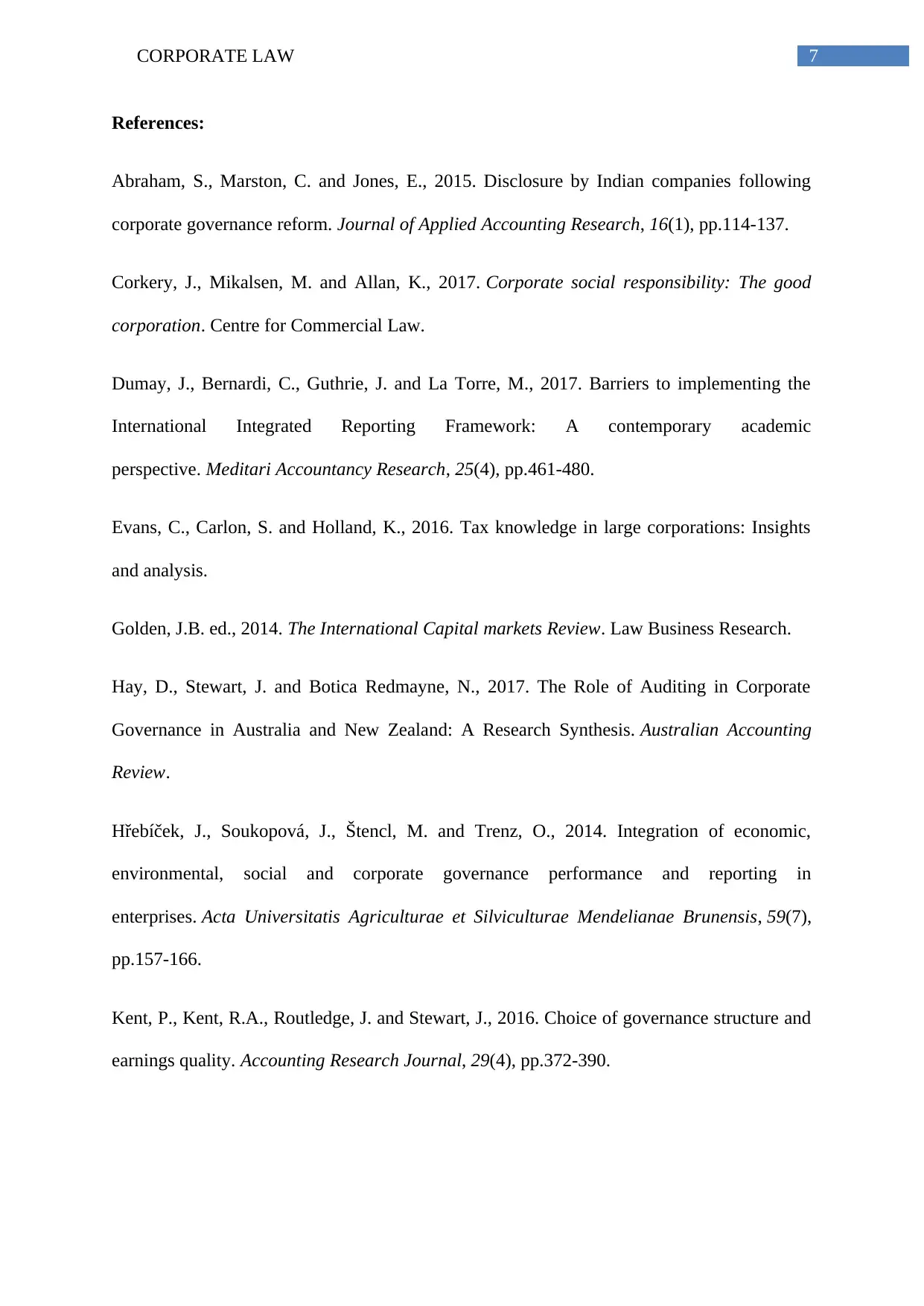
7CORPORATE LAW
References:
Abraham, S., Marston, C. and Jones, E., 2015. Disclosure by Indian companies following
corporate governance reform. Journal of Applied Accounting Research, 16(1), pp.114-137.
Corkery, J., Mikalsen, M. and Allan, K., 2017. Corporate social responsibility: The good
corporation. Centre for Commercial Law.
Dumay, J., Bernardi, C., Guthrie, J. and La Torre, M., 2017. Barriers to implementing the
International Integrated Reporting Framework: A contemporary academic
perspective. Meditari Accountancy Research, 25(4), pp.461-480.
Evans, C., Carlon, S. and Holland, K., 2016. Tax knowledge in large corporations: Insights
and analysis.
Golden, J.B. ed., 2014. The International Capital markets Review. Law Business Research.
Hay, D., Stewart, J. and Botica Redmayne, N., 2017. The Role of Auditing in Corporate
Governance in Australia and New Zealand: A Research Synthesis. Australian Accounting
Review.
Hřebíček, J., Soukopová, J., Štencl, M. and Trenz, O., 2014. Integration of economic,
environmental, social and corporate governance performance and reporting in
enterprises. Acta Universitatis Agriculturae et Silviculturae Mendelianae Brunensis, 59(7),
pp.157-166.
Kent, P., Kent, R.A., Routledge, J. and Stewart, J., 2016. Choice of governance structure and
earnings quality. Accounting Research Journal, 29(4), pp.372-390.
References:
Abraham, S., Marston, C. and Jones, E., 2015. Disclosure by Indian companies following
corporate governance reform. Journal of Applied Accounting Research, 16(1), pp.114-137.
Corkery, J., Mikalsen, M. and Allan, K., 2017. Corporate social responsibility: The good
corporation. Centre for Commercial Law.
Dumay, J., Bernardi, C., Guthrie, J. and La Torre, M., 2017. Barriers to implementing the
International Integrated Reporting Framework: A contemporary academic
perspective. Meditari Accountancy Research, 25(4), pp.461-480.
Evans, C., Carlon, S. and Holland, K., 2016. Tax knowledge in large corporations: Insights
and analysis.
Golden, J.B. ed., 2014. The International Capital markets Review. Law Business Research.
Hay, D., Stewart, J. and Botica Redmayne, N., 2017. The Role of Auditing in Corporate
Governance in Australia and New Zealand: A Research Synthesis. Australian Accounting
Review.
Hřebíček, J., Soukopová, J., Štencl, M. and Trenz, O., 2014. Integration of economic,
environmental, social and corporate governance performance and reporting in
enterprises. Acta Universitatis Agriculturae et Silviculturae Mendelianae Brunensis, 59(7),
pp.157-166.
Kent, P., Kent, R.A., Routledge, J. and Stewart, J., 2016. Choice of governance structure and
earnings quality. Accounting Research Journal, 29(4), pp.372-390.
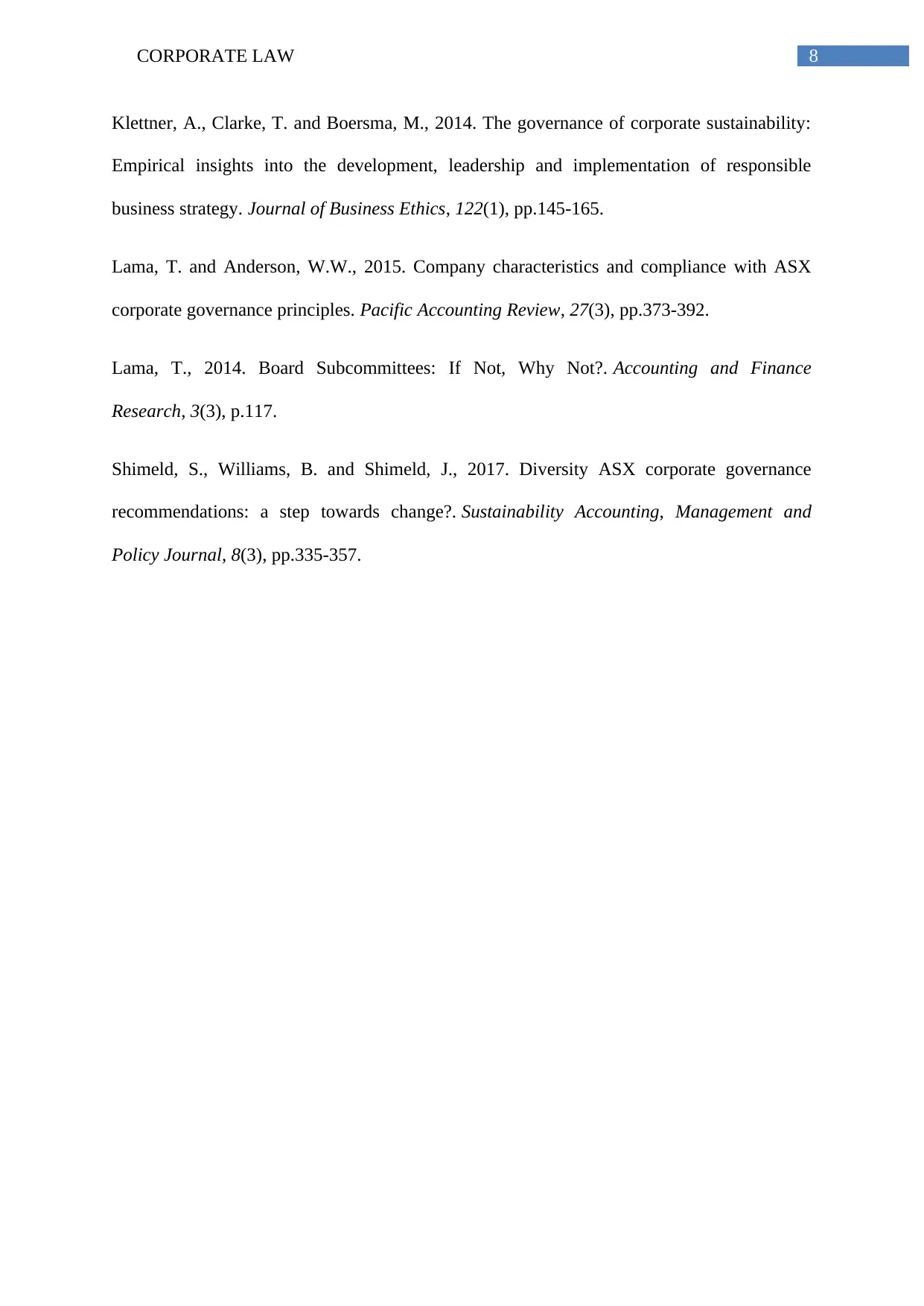
8CORPORATE LAW
Klettner, A., Clarke, T. and Boersma, M., 2014. The governance of corporate sustainability:
Empirical insights into the development, leadership and implementation of responsible
business strategy. Journal of Business Ethics, 122(1), pp.145-165.
Lama, T. and Anderson, W.W., 2015. Company characteristics and compliance with ASX
corporate governance principles. Pacific Accounting Review, 27(3), pp.373-392.
Lama, T., 2014. Board Subcommittees: If Not, Why Not?. Accounting and Finance
Research, 3(3), p.117.
Shimeld, S., Williams, B. and Shimeld, J., 2017. Diversity ASX corporate governance
recommendations: a step towards change?. Sustainability Accounting, Management and
Policy Journal, 8(3), pp.335-357.
Klettner, A., Clarke, T. and Boersma, M., 2014. The governance of corporate sustainability:
Empirical insights into the development, leadership and implementation of responsible
business strategy. Journal of Business Ethics, 122(1), pp.145-165.
Lama, T. and Anderson, W.W., 2015. Company characteristics and compliance with ASX
corporate governance principles. Pacific Accounting Review, 27(3), pp.373-392.
Lama, T., 2014. Board Subcommittees: If Not, Why Not?. Accounting and Finance
Research, 3(3), p.117.
Shimeld, S., Williams, B. and Shimeld, J., 2017. Diversity ASX corporate governance
recommendations: a step towards change?. Sustainability Accounting, Management and
Policy Journal, 8(3), pp.335-357.
⊘ This is a preview!⊘
Do you want full access?
Subscribe today to unlock all pages.

Trusted by 1+ million students worldwide
1 out of 9
Related Documents
Your All-in-One AI-Powered Toolkit for Academic Success.
+13062052269
info@desklib.com
Available 24*7 on WhatsApp / Email
![[object Object]](/_next/static/media/star-bottom.7253800d.svg)
Unlock your academic potential
Copyright © 2020–2025 A2Z Services. All Rights Reserved. Developed and managed by ZUCOL.





